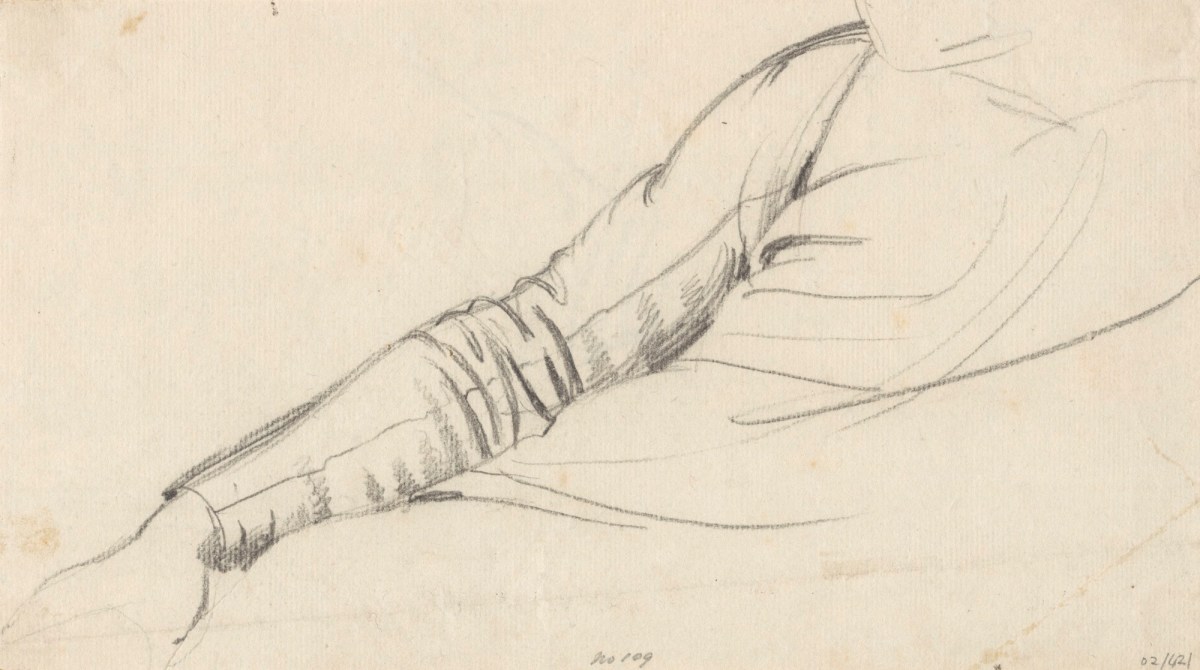
Benjamin Robert Haydon, Study for the sleeping groom in 'Macbeth', ca.1808-11.
Black chalk on off-white laid paper. 15.2 cm x 27 cm. © Photo: Royal Academy of Arts, London.
This image is not available to download. To licence this image for commercial purposes, contact our Picture Library at picturelibrary@royalacademy.org.uk
Study for the sleeping groom in 'Macbeth', ca.1808-11
Benjamin Robert Haydon (1786 - 1846)
RA Collection: Art
These sketches relate to Benjamin Robert Haydon's painting 'Macbeth' (ca.1809-11; untraced). The painting is now lost but descriptions of the finished work by the artist and others indicate that it depicted Shakespeare's character just as he is about to murder King Duncan. 'Macbeth' was commissioned by the influential patron Sir George Beaumont and Haydon was at work on the composition by 1809. Unfortunately, he initially made the painting smaller than had been agreed then enlarged the canvas to such an extent that it could not fit into his patron's house, causing a serious rift in his relations with Beaumont.
Between 1809 - 1810 Haydon experimented with the composition. He first intended to show Macbeth in the act of stabbing Duncan but by May 1809 he had decided that 'it was such a common idea making him stabbing' and instead resolved to portray Macbeth 'grasping the clothes in one hand, the dagger in the other'. As he prepares to murder the King, Macbeth hears something 'and with terror and affright he looks around, and sees the shadow only of Lady Macbeth glimmering in dim half tints at the bottom of the room, the two grooms asleep at the foot of the bed and Duncan as sound and tranquil as if dreaming of Heaven'.
Haydon made copious studies for the 'Macbeth' painting. In 1810 he wrote; 'I advanced and fell back and advanced again; Macbeth's head I painted and repainted...I moulded torsos for the chest of Macbeth. I moulded knees for the sleeping grooms. I made studies without end; hands over and over again - from nature, from the antique. Models sat till night. My lamp often burnt deep into it.' Judging from the Royal Academy drawings, Haydon did make many studies of hands, legs and chests as well as compositional sketches and more specific studies for the figures. His models were Corporal John Sammons and a soldier named Dakin whom, Haydon recorded 'sat to me for the sleeping groom on his knees in Macbeth' and was later 'cut to pieces' at the battle of Waterloo.
Haydon's description of the finished painting suggests that he generally adhered to the concept he had formulated by May 1809 with a couple of significant changes. In the finished work, for instance, Macbeth holds daggers in two hands; 'his hands fixed and and grasping the daggers with supernatural clutching energy'. The grooms were also been moved from the bed to the foreground with Macbeth, in a dynamic pose, standing between them and the unfortunate King.
Object details
15.2 cm x 27 cm



